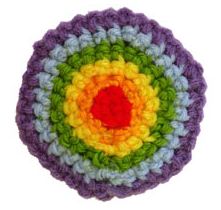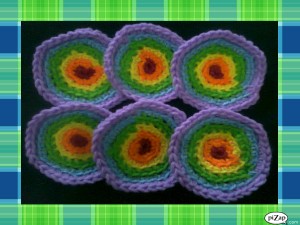Golden Treasures in Rainbow Coasters
By A Guest Writer – 8 CommentsA Guest Post by Eve Tallafer-Sison.
“There’s a pot of gold at the end of the rainbow.” I realized the truth in this saying while working on the pattern of the Rainbow Coaster by Rachel at Crochet Spot. At first glance, the attraction has been irresistibly strong because of the design. The color combination allows pairing the coaster with any placemat or tablecloth. Aside from the fact that the instructions are reader-friendly, making it is very easy to follow, crocheting a whole set of it added these precious gems into my treasury:
- A stitch in time saves nine. Making a single mistake in counting in Round 1 spoils the whole plan. Like for this coaster, the 2 sc in each sc around starting in Round 2 provides the foundation of the hexagonal pattern. Making a mistake in the previous row affects the intended formation. This goes to say that every stitch in a row has a purpose and each single stitch counts in the entire project.
- Practice makes perfect. An old saying, yes, but while working on each piece of the coaster set, I was able to prove it in the area of changing the color of yarn. While it is true that I learned to crochet at an early age, I worked on all my projects using only one color. I came to practice the art of changing threads recently from online literature and tutorials from YouTube. This coaster was a perfect exercise indeed for me to master the craft as the pattern required changing the color of yarn five times.
- Rhythmic numeric chants lead to mastery. People usually repeat what they say in order to strike a point. Familiar with the idiom that states, “The key to mastery is frequent repetition?” I realized the same is true in crochet. Using repetitive numeric chants that create a rhythm helps one memorize instructions and master patterns more quickly. Let me show you how.
Take a look at the pattern for this Rainbow Coaster:

Round 1: with red, ch 2, 6 sc in second ch from hook, changing to orange in last sc made: 6 sc
Round 2: 2 sc in each sc around, changing to yellow in last sc made: 12 sc
Round 3: (2 sc in next sc, sc in next sc) around, changing to green in last sc made: 18 sc
Round 4: (2 sc in next sc, sc in next 2 sc) around, changing to blue in last sc made: 24 sc
Round 5: (2 sc in next sc, sc in next 3 sc) around, changing to purple in last sc made: 30 sc
Round 6: (2 sc in next sc, sc in next 4 sc) around, sl st in next sc, finish off: 36 sc
While working on this, creating a numeric rhythm for pattern directions suddenly popped up in my mind. As if I were in a trance, I couldn’t stop myself from chanting mentally. Here are all the rhythmic chants I used for the coaster:
In Round 2: “One and two, one and two” while executing the “2 sc in each sc around”
In Round 3: “One, two and one. One, two and one†while crocheting the “2 sc in next sc, sc in next sc around”
In Round 4: “One and two, one, one; one and two, one, one†was effective in memorizing the execution of “2 sc in next sc, sc in next 2 sc”
In Round 5: “One and two; one, two, three; one and two; one, two, three” for the “2 sc in next sc, sc in next 3 sc”
In Round 6: “One and two; one, two, three, four; One and two; one, two, three, four” for the “2 sc in next sc, sc in next 4 sc”
Chanting this numeric rhythm eliminated the need of referring to the instructions frequently throughout the crochet period. By the time I finished one coaster, I have almost memorized the pattern. Completing the remaining five came a lot faster! This technique helped me finish the whole set in a jiffy!

Now, how about giving the technique a try in any of your other crochet projects and see if, just like me, you also find it helpful. Tell me how fast you can finish your project with and without chanting in rhythm.
Eve is a nurse by profession working in a Cardiac Hospital in the Philippines. Next to cooking, crochet is her hobby, a craft she learned from her mother. Doing picture collages is her other favorite hobby.


This is exactly what I do and what I teach my pupils to do.
From the very early stages I show them that each stitch has it’s own “rythmn” too. e.g. DC has 2 stages so two beats and TC 3 stages so 3 beats etc.
Great post. It’s good to share!
I just joined, and getting back to my crochet is helped so much here.the counting tip.It saves my back and forth pattern looking.thanks for the tip.
Hi everyone,
marion
To avoid confusion when increasing in rounds or rows, I teach my students (as well as practicing it myself) to use letters for the increases. For example, if the pattern says sc in next stitch, 2sc in next around, I say “one, A B, one A B) this avoids confusing the regular stitches with the increases when using all numbers.
I too have used the rhythm thing to keep up with where I am in the pattern. and I found it
very helpful in getting the right number of stitches in each row as well as getting the stitches
in the right place. 🙂
I go one, double-up, two, double-up, etc. The double is for one stitch, the up for the next. Don’t laugh, but if there are three stitches in one stitch I go ding, dong, ding. Nuts I know, but what ever works to get the job done.
Hello Eve, I also use this number system and you’re right, once you get into the rythm, it’s very easy to get the job done without looking back and forth to the pattern; it’s also easy to memorize the pattern your’re working on using this method. Thank you! ~ Dawn ~
Whenever I’m working in the round, I find it helpful to count 1, 2-3 in the third row, 1,2,3-4 in the fourth row, and so on. But I just never thought of it as a rythmic chant! Clever!
I say one aum ….two aum…and so on as Aum stands for all god creates and is a very powerful word in yoga.The rhythm of crochet is easier and soothing with this chant.Try it …….it works wonders!